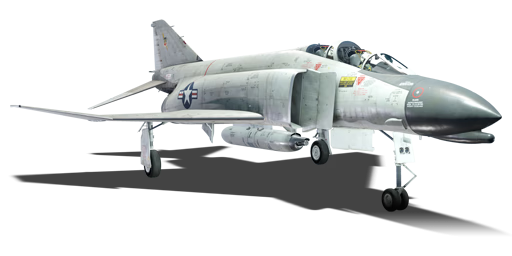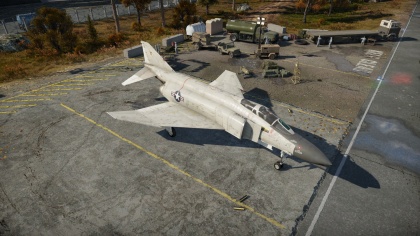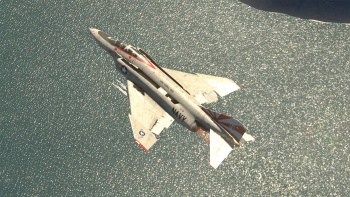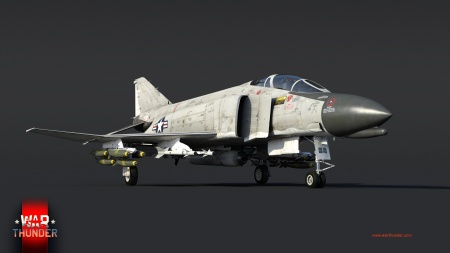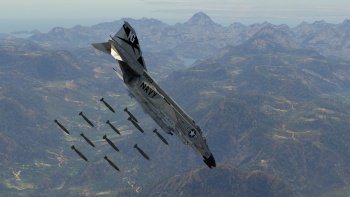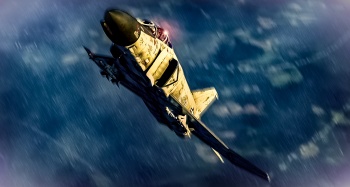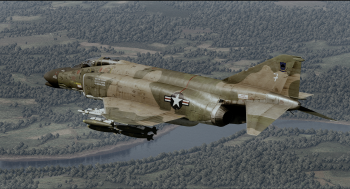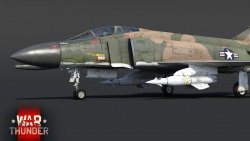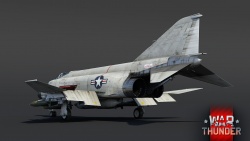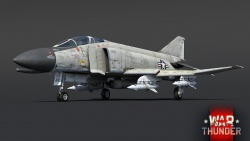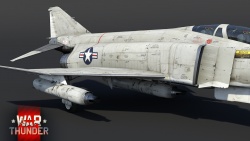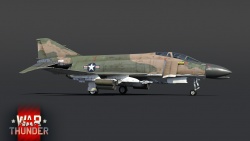Difference between revisions of "F-4C Phantom II"
(Added images.) |
m (Edits.) |
||
| Line 135: | Line 135: | ||
|- --> | |- --> | ||
|} | |} | ||
| − | [[File:F 4 phantom sgtroach.png|350px|thumb|right|''Fox-2, Fox-2'' - ROKAF '''{{PAGENAME}}''' launching | + | [[File:F 4 phantom sgtroach.png|350px|thumb|right|''Fox-2, Fox-2'' - ROKAF '''{{PAGENAME}}''' launching an [[AIM-9B]] Sidewinder missile.]] |
=== Survivability and armour === | === Survivability and armour === | ||
''Examine the survivability of the aircraft. Note how vulnerable the structure is and how secure the pilot is, whether the fuel tanks are armoured, etc. Describe the armour, if there is any, and also mention the vulnerability of other critical aircraft systems.'' | ''Examine the survivability of the aircraft. Note how vulnerable the structure is and how secure the pilot is, whether the fuel tanks are armoured, etc. Describe the armour, if there is any, and also mention the vulnerability of other critical aircraft systems.'' | ||
Revision as of 17:57, 27 September 2019
Contents
Description
The F-4C Phantom II is a rank VII American jet fighter with a battle rating of 10.7 (AB/SB) and 10.3 (RB). It was introduced in Update 1.91 "Night Vision".
Development of fighter aircraft attempts to balance size, speed, armament and manoeuvrability to come up with the perfect fighter. Due to the difficulties and challenges of bundling all of these in one aircraft, many different varieties have been developed through the years which highlighted one or more aspects but rarely all in one. And sometimes the mold had to be broken and the motto “bigger IS better” came into play. Due to these such heavyweight fighters like the P-61, Me 410, Beaufighter, J5N1 and SM.91 were developed to fly faster, remain maneuverable and carry heavier weapons and ordnance, sometimes much heavier than their lighter counterparts. The F-4C Phantom II is no exception, originally developed as a suped-up F-3H Demon, this fighter was modified into a larger, heavier, faster fighter-interceptor/bomber that the U.S. Navy didn’t realize it needed and when it did, it went all in.
The imposing F-4C Phantom II can seem a bit intimidating at first due to its size, but the pilot will quickly find out with the dual J79-GE-15 engines that this fighter is no slouch. Going from takeoff, acceleration in a climb and to level flight the F-4C Phantom II will move and is quite agile for an aircraft of its size. More than capable as a dogfighter, it, however, has many options up its sleeve do deal with enemy aircraft it may encounter. Pilots new to the F-4C Phantom II will initially be set up with an M61 20 mm cannon. Due to this aircraft not being configured with an internal cannon, one was required to be mounted on a centre-line pylon. Options become available to mount two additional 20 mm cannon gun pods, one under each wing which all together will spew out a slew of 20 mm rounds acting like a shotgun effect even at +500 m. AIM-9B Sidewinder missiles round out the Phantom’s anti-air capabilities and is a solid missile to use against enemy aircraft which will cause the enemy pilot to take evasive manoeuvres to avoid the missile, in the event that happens, be ready with the cannons for backup as the enemy pilot should be an easy target after bleeding all of their speed and energy avoiding the missile.
Another arena where the F-4C Phantom II shines is in the ground-pounding or ground attack function of the aircraft. With eleven hardpoints, this fighter/bomber can be configured in many different ways to carry a combination of guns, bombs and rockets. When it comes to bombs, the F-4C Phantom II has the option to use either 250 lb, 500 lb, 750 lb or 1,000 lb bombs and can hold upwards of 9,000 lbs total! The Phantom also has three different rocket types to choose from, depending on the targets you are going after. These range from anti-tank AGM-12B and AGM-12C Bullpup guided rockets, Zuni Mk32 anti-tank rockets and the small but powerful FFAR Mighty Mouse in volume of 228, which can be devastating when used en masse.
The amazing F-4 Phantom II was state-of-the-art in its day and even 60 years later, several countries are still utilising this iconic fighter/bomber as a force multiplier with their air forces today. This fighter coupled with a pilots skill and determination can help alter the outcome in the jet-battle matches.
General info
Flight performance
Describe how the aircraft behaves in the air. Speed, manoeuvrability, acceleration and allowable loads - these are the most important characteristics of the vehicle.
| Characteristics | |||||||
|---|---|---|---|---|---|---|---|
| Stock | |||||||
| Max Speed (km/h at ????? m) |
Max altitude (meters) |
Turn time (seconds) |
Rate of climb (meters/second) |
Take-off run (meters) | |||
| AB | RB | AB | RB | AB | RB | ||
| ???? | ???? | 16000 | ??.? | ??.? | ??.? | ??.? | ???? |
| Upgraded | |||||||
| Max Speed (km/h at ????? m) |
Max altitude (meters) | Turn time (seconds) | Rate of climb (meters/second) |
Take-off run (meters) | |||
| AB | RB | AB | RB | AB | RB | ||
| ???? | ???? | 16000 | ??.? | ??.? | ??.? | ??.? | ???? |
Details
| Features | ||||
|---|---|---|---|---|
| Combat flap | Take-off flap | Landing flap | Air brakes | Arrestor gear |
| ✓ | ✓ | ✓ | ✓ | ✓ |
| Limits | ||||
|---|---|---|---|---|
| Wing-break speed (km/h) |
Gear limit (km/h) |
Combat flap (km/h) |
Max Static G | |
| + | - | |||
| 1458 | 463 | ??? | ~?? | ~?? |
| Optimal velocities | |||
|---|---|---|---|
| Ailerons (km/h) |
Rudder (km/h) |
Elevators (km/h) |
Radiator (km/h) |
| < ??? | < ??? | < ??? | > ??? |
| Compressor (RB/SB) | ||
|---|---|---|
| Setting 1 | ||
| Optimal altitude | 100% Engine power | WEP Engine power |
| 0 m | ???? kgf | ???? kgf |
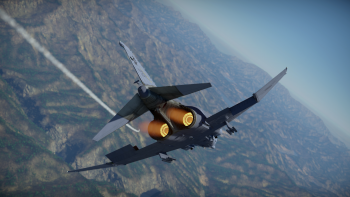
Survivability and armour
Examine the survivability of the aircraft. Note how vulnerable the structure is and how secure the pilot is, whether the fuel tanks are armoured, etc. Describe the armour, if there is any, and also mention the vulnerability of other critical aircraft systems.
Armaments
Suspended armament
The F-4C Phantom II can be outfitted with the following ordnance:
- 1 x 20 mm M61 Vulcan rotary cannon in a SUU-16/SUU-23 gun pod (approximately 1200 rounds)
- 2 x additional SUU-16/SUU-23 gun pods for a total of 3 x M61 Vulcan 20 mm cannons
- 18 x 250 lb. Mk.81 bombs (4,500 lbs total)
- 18 x 500 lb. Mk.82 bombs (9,000 lbs total)
- 12 x 750 lb. M117 cone 45 bombs (9,000 lbs total)
- 8 x 1000 lb. Mk.83 bombs (8,000 lbs total)
- 2 - 4 x AGM-12 Bullpup Air-to-Surface Missiles
- 48 x Mk. 32 Zuni ATAP rockets
- 228 x FFAR Mighty Mouse rockets
- 4 x AIM-9B Sidewinder missiles
It is rare for a fighter not to have any native offensive weapons, typically this is a situation you would find on a bomber. The F-4C Phantom II is unique in that what it lacks in offensive weapons, it more than makes up for in suspended weapons. With a total of 11 hardpoint pylons, an array of guns, bombs, rockets and missiles can be added, fully customizing the mission to suit the needs of the pilot. The pilot has the choice of configuring for air-to-air, air-to-ground or a mixture of both (bombs and Bullpup rockets are ground attack only, missiles are air-to-air attack only while the cannons, Zuni and FFAR rockets can be used for both).
In regards to air-to-air combat, the F-4C Phantom II is hard-pressed to find a competitor on equal footing, but that can be found with an exceptional pilot flying a less than equal aircraft. This fighter is fast and with its speed, it can relatively sneak up on enemy fighters by closing the gap on the field with its twin J79-GE-15 engines. Once in place and the enemy is in range, two options are available, guns or missiles? The M-61 Vulcan cannon can spew 20 mm rounds at the rate of just over 6,000 rounds per minute (roughly 100 per second), now multiply that by three (if the Phantom is configured for three gun pods) and you can see devastating firepower which will be difficult for any enemy aircraft to avoid. Even just quick bursts at a manoeuvring fighter can be enough to inflict critical damage or even blowing off a wing. Ground attack with the guns can be effective on lighter armoured vehicles with just a few quick bursts.
The AIM-9B Sidewinder is the missile option available for the F-4C Phantom II. During the Vietnam War when F-4D model aircraft began operations, it did so without the capability of mounting AIM-9 Sidewinder missiles, just Sidewinders. Sidewinders had gained a reputation of not being reliable (not firing, not tracking, not exploding) so several squadrons had their F-4D fighters field outfitted with the ability to mount their trusted Sidewinder missiles. Here on the F-4C Phantom II, four Sidewinders are available and are very effective at hounding down an aircraft when a lock is acquired. Though not 100% chance to hit, a very competent pilot can avoid them, however, it will cost much in speed and situational awareness that it ends up making them an easy target to clean up with the cannons.
Zuni and FFAR rockets can be utilised effectively against bombers or even against other fighters, especially during a head-on. Though unguided and not very accurate, usually a salvo of these rockets is enough to cause an enemy to panic into an unexpected manoeuvre. Usage of these rockets on ground targets works very well too. Again, with them being unguided, shooting them en masse ensure greater possibility of one or more to hit the target. The AGM-12B Bullpup rockets are excellent rockets to use against ground targets, however, the one drawback is that it needs to be guided in by the pilot, so if there are any distractions to the pilot, the rocket will likely go off course and miss the target.
9,000 lbs. Yes, you read that number correctly, the F-4C Phantom II can carry up to 9,000 lbs of bombs, which is half of what a B-29 bomber could carry, however, the Phantom is quite a bit more accurate dropping from much lower altitudes. Using combinations of 250, 500, 750 and 1,000 lb bombs allows the pilot to pick targets accordingly. To ensure the F-4C Phantom II is not left defenceless after the bombs are away, each configuration has at least one 20 mm cannon pod and/or AIM-9B missiles to go with it.
Usage in battles
Describe the tactics of playing in an aircraft, the features of using vehicles in a team and advice on tactics. Refrain from creating a "guide" - do not impose a single point of view, but instead, give the reader food for thought. Examine the most dangerous enemies and give recommendations on fighting them. If necessary, note the specifics of the game in different modes (AB, RB, SB).
Pros and cons
Pros:
- Centerline gun pod is default weapon on all load-outs
- Wide variety of payload options to include 20 mm cannons, rockets, missiles and bombs
- One of the fastest aircraft in the game pushing Mach 2
- Has access to the fantastic AIM-9 Sidewinders air-to-air missiles
- Excellent rate of climb
- Good roll rate
- M61 Vulcan is devastating to enemy aircraft (especially when three gun pods are outfitted)
Cons:
- Missiles are a Tier IV modification which requires unlocking before use
- Large target profile compared to other fighters
- When maxed out at 24 t (21,800 kg/48,000 lb) manoeuvrability suffers
History
Devblog
In the early 1950s, McDonnell Aircraft began work on a revised design of their F3H Demon naval fighter, in an effort to expand upon its capabilities and improve performance in general. By September 1953, the design was submitted for Navy consideration. Showing interest in the project, the U.S. Navy ordered the construction of a mock-up and expressed interest in potentially procuring the type.
By 1955, however, the U.S. Navy changed the requirements for the aircraft substantially. Instead of a multipurpose aircraft, the new design was now supposed to act as a two-seat, long-range, all-weather fleet interceptor. Having revised the design, orders were issued for the construction of two XF4H-1 prototypes as well as an additional five pre-production F4H-1s. Following comparative testing against other machines in service with the Navy at the time, the F4H proved itself as highly capable aircraft and was thus ordered into full-scale production as the F-4. The name ‘Phantom II’ was given to the aircraft at McDonnell’s 20th anniversary celebration in July 1959.
Some time after the Navy procured the F-4, other branches of the U.S. military also became interested in the aircraft. A result, the USAF also introduced a special “army” version of the F-4 into service during the mid 1960s under the designation F-4C.
The F-4 Phantom II would become one of the most produced and widely used American combat aircraft of the second half of the 20th century. With over 5,100 machines being built, the F-4 Phantom II saw service with several operators around the globe and remained in service until the 1990s, while some still serve to this day. Phantom II is widely known as a symbol of the US campaign in Vietnam, in particular.
Media
Notable pilots
-
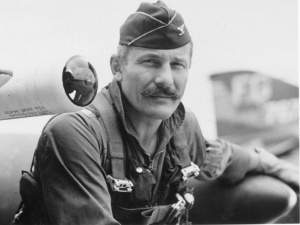 During the Vietnam war Robin Olds flew the F-4C and F-4D fighters and failed to claim aircraft kills after #4 to prevent attaining ace status to remain flying in the war as long as possible.
During the Vietnam war Robin Olds flew the F-4C and F-4D fighters and failed to claim aircraft kills after #4 to prevent attaining ace status to remain flying in the war as long as possible.
See also
Links to the articles on the War Thunder Wiki that you think will be useful for the reader, for example:
- reference to the series of the aircraft;
- links to approximate analogues of other nations and research trees.
External links
| USA jet aircraft | |
|---|---|
| Fighters | |
| F9F | F9F-2 · F9F-5 · F9F-8 |
| F-80 | F-80A-5 · F-80C-10 |
| F-84 | F-84B-26 · F-84F · F-84G-21-RE |
| F-86 | F-86A-5 · F-86F-25 · F-86F-2 · F-86F-35 |
| F-89 | F-89B · F-89D |
| F-100 | F-100D |
| F-104 | F-104A · F-104C |
| F-4 | F-4C Phantom II · F-4E Phantom II · F-4J Phantom II · F-4S Phantom II |
| F-5 | F-5A · F-5C · F-5E · F-20A |
| F-8 | F8U-2 · F-8E |
| F-14 | F-14A Early · ▄F-14A IRIAF · F-14B |
| F-15 | F-15A · F-15C MSIP II · F-15E |
| F-16 | F-16A · F-16A ADF · F-16C |
| Other | P-59A · F2H-2 · F3D-1 · F3H-2 · F4D-1 · F11F-1 |
| Strike Aircraft | |
| FJ-4 | FJ-4B · FJ-4B VMF-232 |
| A-4 | A-4B · A-4E Early |
| A-7 | A-7D · A-7E · A-7K |
| AV-8 | AV-8A · AV-8C · AV-8B Plus · AV-8B (NA) |
| A-10 | A-10A · A-10A Late · A-10C |
| F-111 | F-111A · F-111F |
| Other | A-6E TRAM · F-105D · F-117 |
| Bombers | |
| B-57 | B-57A · B-57B |


